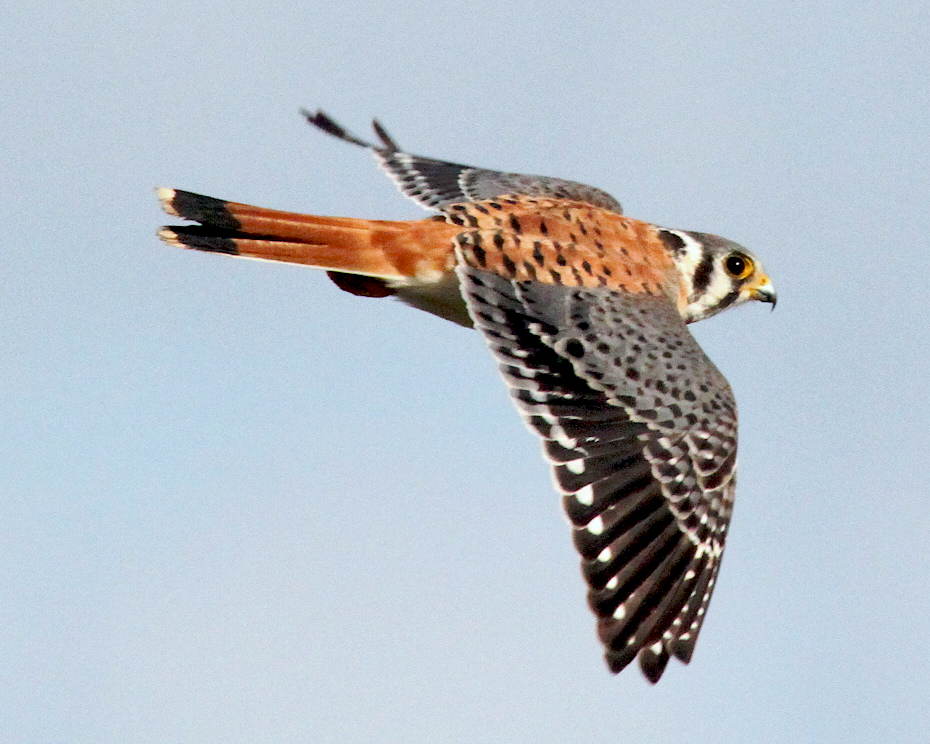Did you see the photo the two Canadian brothers took with a Bald Eagle? The brothers were on a hunting trip in Dowling, Canada, when they found a Bald Eagle with its claw stuck in a trap. The brothers, who videoed their encounter, calmed the bird by placing one of their hoodies over it and used a stick to pry open the trap. Before releasing the bird to fly away, they took a pretty incredible photograph. Without a doubt, the Bald Eagle is among the most majestic of raptors, indeed the brothers marveled at the sheer size of the bird, considered the largest true raptor in North America, but when it’s winter in Texas we find ourselves equally intrigued by the other end of the raptor scale.
The American Kestrel is the smallest falcon in North America and, under traditional classification, the smallest raptor, weighing a mere 3-6 ounces with a wingspan of 20-24 inches. Overall, they’re about the size of a Mourning Dove. By contrast, the Bald Eagle weights 6.6.–14 pounds with a wingspan of 5.9 – 7.5 feet. While their size may be considerably less than their iconic raptor relative, the American Kestrel is no less fascinating.
The American Kestrel, which migrates to Texas for the winter, can often be seen perched on power lines near open fields, searching for large insects, bats, mice, birds and small reptiles. A bob of the head and a wag of its tail usually means the prey has been spotted. Ready to strike, the kestrel makes a direct flight toward the prey to grab it in its talons. As it dines on many farm pests, insects and mice in particular, the American Kestrel may be considered something of a farmer’s friend. According to Hawk Mountain Sanctuary Association, some grape growers use kestrels to control flocks of grape-eating starlings, finches and robins that move into vineyards as fruit ripens. American Kestrels often hunt as a family group, giving the young ones a chance to hone their hunting skills with their parents.
Unlike many other raptors, American Kestrels are sexually dimorphic; that is, the male and female have distinctive traits. While the female is slightly larger, the male is particularly striking with blue-gray wings contrasting with a rust-colored back and tail. Both male and female have dramatic black and white facial markings, a sort of vertical mask, making this mighty predator in a tiny package look like something straight out of a Marvel comic book.
Although commonly used in falconry, American Kestrels are protected by the Migratory Bird Treaty Act of 1918 and are illegal to possess without a permit in the United States, Canada, and Mexico. They are also under the watchful eye of the American Kestrel Partnership, a network of citizen and professional scientists working together to advance kestrel conservation. According to the organization, they are currently recording data from more than 1,400 kestrel nests from Alaska to Argentina. For more information on the American Kestrel partnership and its work, visit http://kestrel.peregrinefund.org.
American Kestrels are cavity nesters, preferring a natural cavity, a woodpecker hole, or crevice in a tree, but a shortage of natural cavities for nesting may limit their population size. In Texas, their breeding range is restricted to North Texas and far West Texas. If your property is in these areas and you’re interested in attracting these tiny but mighty colorful birds of prey to your property, consider adding a kestrel nest box.
Photo of American Kestrel, top, via US Fish and Wildlife Service.










